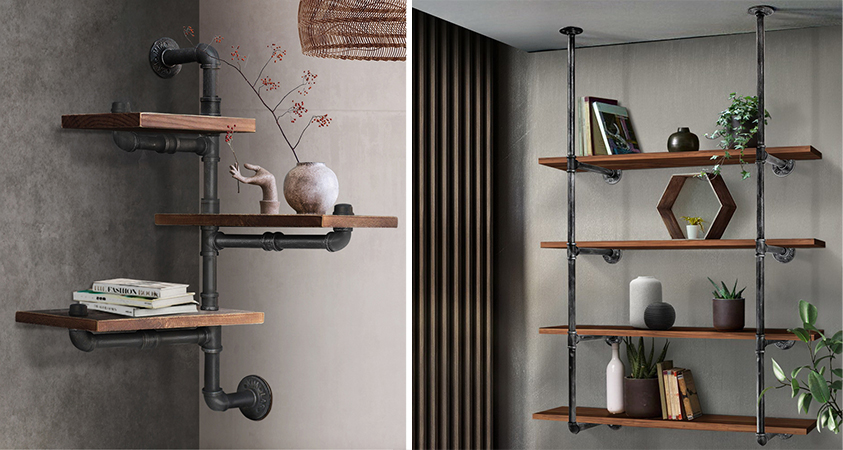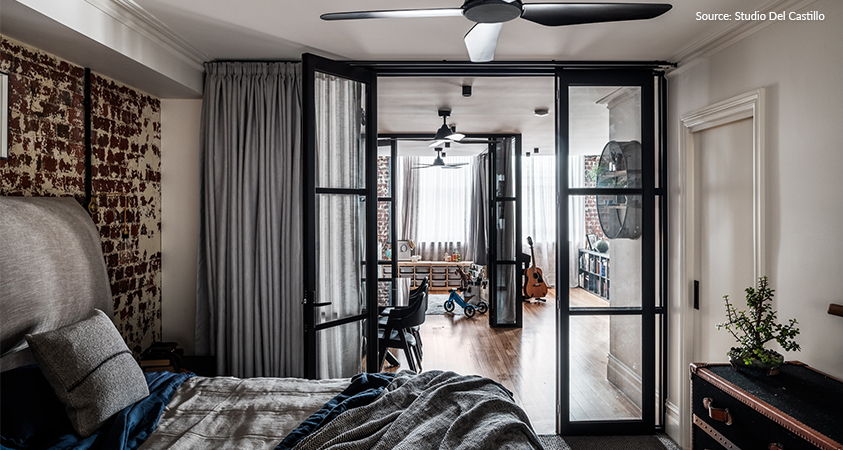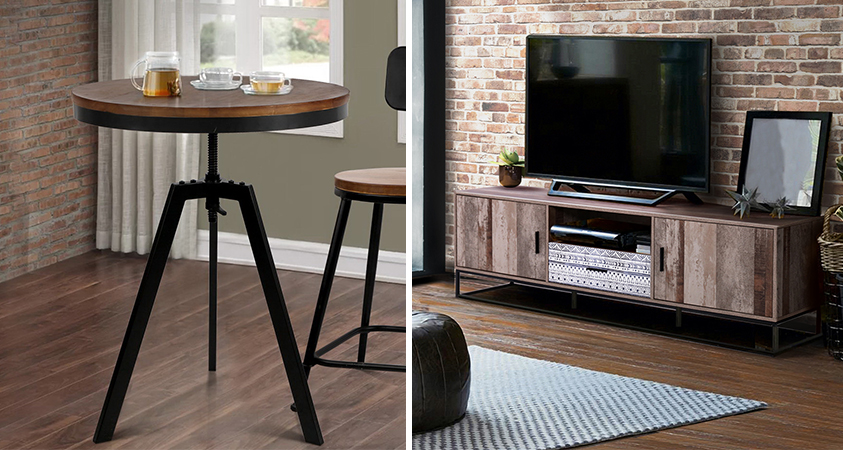Industrial Interior Design Guide
Do you love anything vintage? Then you’re going to love what we have to say about industrial interior design. This style takes cues from the past and turns them into something completely new, fresh and modern. With plenty of rough, raw elements combined with sleek contemporary conveniences, this surprisingly flexible style will make you feel at home anywhere. If you want to experience a piece of history for yourself, read on and find out how you can modern industrial interior design turn an abandoned building into the next trending home.

What is Industrial Interior Design?
Industrial interior design is a style that combines raw materials and man-made elements to create a sleek and modern look. While it takes many cues from minimalism, in part thanks to its utilitarian beginnings, it is a style that highlights how far technology, and human’s ability to create, has come.
The History of Industrial Design
The history of industrial interior design is inextricably linked to the growth of industrialisation and mechanisation that came out of the industrial revolution. The exact beginnings of the term are up for debate. However, it supposedly goes all the way back to the 1850s, with the publication of the Practical Draughtsman’s Book of Industrial Design by Jacques-Eugène Armengaud. During the industrial revolution, new factories were constructed all over the world to make the most of new manufacturing technology. These factories were very practical with little decoration and many architectural elements like pipes left exposed. As manufacturing technology improved, many of these factories shut down but remained standing. These industrial spaces needed a new purpose, and so they became industrial-style housing.

Industrial interior design embraces the original factories' design and purpose. Instead of hiding the inner workings of the home, these industrial elements are celebrated and left on display. Despite their pragmatic origin, industrial homes often have a casual, relaxed feel with a touch of minimalism.
The Key Features of Industrial Interior Design
Exposed architectural elements
Reclaimed and exposed brick, concrete, pipes and rafters are staples of this interior style. An industrial-style home is a piece of preserved history - the more ways you can find to celebrate it, the better.

Neutral palettes
Industrial-style interiors make use of monochromatic neutral colour palettes. While many other minimalist interior styles use lighter shades such as white and pale grey, industrial interiors will lean into darker tones such as black and brown.
Vintage and repurposed pieces
If there’s one thing industrial design loves, it’s recycling. Whether it’s vintage wood furniture, a refurbished antique or a set made from reclaimed materials, giving these pieces a second life will help bring natural elements into the home, add historical value to your home, and support sustainable practices.

Clean lines and sharp silhouettes
Clean lines, both straight and contoured, give industrial-style homes a neat, sleek, elegant look. Furniture shapes are simple, the room is minimally decorated, and there are few ornate patterns or flourishes.
Metallic accents and finishes
The industrial revolution was an age of steel and iron. Naturally, most of these materials have survived into the modern age, and metal elements feature heavily in this interior style. Many industrial decor pieces feature metal frames, while others may feature gold, silver, bronze or copper accents. You might even feature a steel accent wall or other focal points, such as a stainless steel kitchen.

Man vs Nature
Naturally, the industrial revolution made light work of manufacturing metal and glass. Man-made materials like steel, glass, concrete and cut stone feature heavily. In contrast, wood additions bring nature back into the home and provide much-needed warmth and colour among the grey and black.

Bare Edison bulbs
Edison bulbs are carbon or tungsten filament incandescent lightbulbs. These bulbs are often reproductions of popular wound filament bulbs sold by the Edison Electric Light Company, hence the name. These bulbs produce a warm yellow glow that accentuates the surrounding décor and fills the home with warm tones. These bulbs are often the focal point of a fixture as opposed to a hidden element.

How to Create an Industrial Interior Design in Your Home
Cut back your décor
While industrial design is not strictly minimalist, it does take a lot of cues from the style. Industrial homes embrace stripping back and creating a practical interior, so you should consider decluttering as your first step to building an industrial interior. You don’t have to empty your home completely, just consider whether your décor complements or distracts from your home’s natural elements.
Make the building your focus
Unlike most interior styles where the home is a frame for décor, industrial interiors make the building a focal point. Try to decorate in ways that highlight the home’s natural architecture and preserve original elements where possible.

Secondhand treasures
Whether thrift store finds or upcycled DIY projects, giving furniture a second life is a core tenant of industrial style. Vintage furniture with rustic elements can bring warm tones into the home, breathe life into a stark interior, and merge the past and present in style.
Industrial shelving
Not every wall in the home needs to be bare. Show off your personal collections with some industrial-style pipe shelves. These shelves reproduce the classic industrial style with genuine metal exposed pipes and solid pine wood, and the shelves can be configured in many different ways to suit your exact space needs. Perfect for any room, these shelves will blend seamlessly into any industrial-style home.
Vintage lighting
Edison light bulbs are an industrial fan favourite, but they aren’t the only type of light you can use in your home. Metal fixtures are a popular addition, often featuring Edison blubs in a transparent or wide-bar cage. Pendant lights suit kitchen and dining room settings for practical and efficient mood lighting, or you could go for something more subtle like this vintage-style wood floor lamp.
Colour your life
This style relies heavily on dark neutrals, but don’t be afraid to add a pop of colour to personalise your space. Red and orange are popular colours that suit this style, though cool tones such as teal and jade will also suit your space.
Remix your style
Not married to a single décor style? Industrial interior style can easily be combined with many other interior styles for a unique remixed interior that you’ll love. For an industrial x boho style, add plenty of textured fabrics and patterns and lean away from minimalism using plenty of industrial shelving. Industrial and farmhouse styles both share a love of exposed architectural elements and reclaimed materials, while industrial and modern both enjoy open floor plans, minimal decoration and simple shapes. There are many ways you can blend the past and the present by combining the industrial look and other styles into a beautiful, personalised space.
Examples of Industrial Interior Design
The Osborne Project in Mt Martha, designed by The Little Brick Studio, is a great example of modern industrial design. Immediately you notice the exposed brick walls and wide bay windows with a black metal frame. Stone and wood feature heavily, with a grey stone floor, a wood and marble kitchen, and a pale wood dining table. Look up and you’re greeted with exposed metal beams and a combination of drop-down lights and artistic pendant lights illuminating the space. A black metal staircase leads to the second level. To add warmth to the room, this modern industrial living room features a dark blue rug, a grey ottoman, and plenty of potted plants.
This Wiley Park property by Alamay Constructions is a perfect example of a blended industrial design. This kitchen combines industrial and rustic in a way that elevates both styles. Once again we see exposed brick combined with a marble backsplash and concrete floors. Wrought iron chairs feature patterned cushions. The benches feature decorative moulding - enough to provide visual interest but not enough to take away from the rest of the décor. The space above the stove is filled with industrial-style copper pipe shelving that holds both kitchen essentials and a range of vintage knick-knacks. The kitchen is illuminated with tracked pendant lights with bright yellow Edison bulbs, directly shining on the kitchen island for effective task lighting. Looking up, you can see a glimpse of a black mesh banister, supported by an exposed metal beam that sits at the edge of the kitchen.
This industrial-style bedroom by Studio Del Castillo shows that utilitarian design can also be cosy. Exposed brick walls are in stark contrast with the plush grey bedhead. The separating walls are made of glass and black metal, giving the illusion of an open plan. A grey curtain acts as a privacy screen. The room is minimally decorated with deep blue and grey bedsheets, an antique trunk, a potted plant and a minimalist black ceiling fan. Through the window, you can see right into a children’s playroom and the living room, and the hallway features a round shelf with a metal frame and wood tiers.
However you envision your industrial-style home, we have a wide range of products to suit your décor dreams. We have everything from dining tables to entertainment units, giving you a consistent style throughout your home. Made from quality materials and delivered by our dedicated courier partners, you’ll have the interior of your dreams in no time. Check out our range today or visit our blog 17 Popular Interior Styles to find even more creative home inspiration.
Interior Design FAQs
What is industrial interior design?
Industrial interior design is a style that combines raw materials and man-made elements to create a sleek and modern look. It came about during the industrial revolution, and it was popularised when the increasing demand for housing caused many abandoned factories to be converted into homes.
Is industrial design different from industrial interior design?
Industrial design is a process of design used to determine and define the form of a product prior to manufacturing. Industrial interior design is a home decorating style inspired by the industrial revolution.
















